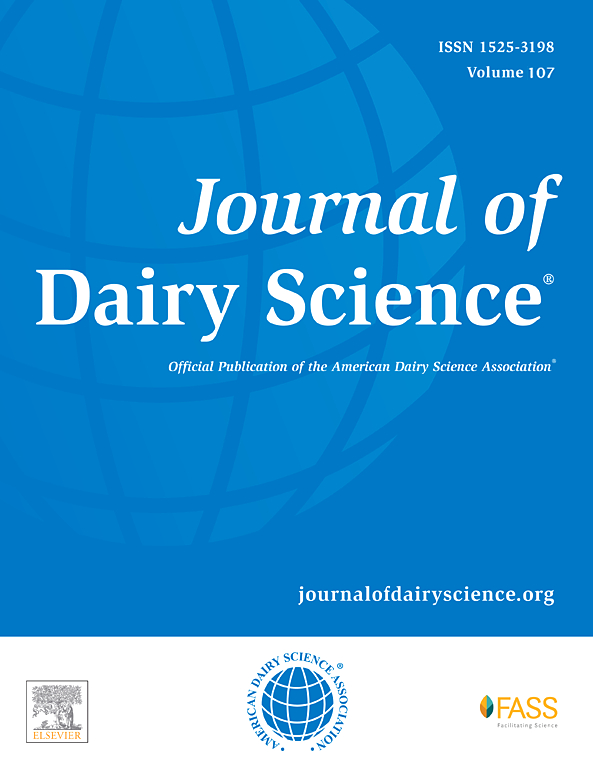The quality and technological parameters of milk obtained from dairy cows with subclinical mastitis
IF 3.7
1区 农林科学
Q1 AGRICULTURE, DAIRY & ANIMAL SCIENCE
引用次数: 0
Abstract
Mastitis is one of the most common diseases in dairy cattle. It significantly reduces milk quality and yield, thus incurring economic losses for farmers. This study investigates the impact of various bacterial pathogens on the SCC, milk composition, and technological properties of milk samples from 302 clinically healthy Polish Holstein-Friesian cows kept under intensive rearing conditions. Of the 462 milk samples analyzed, 85.06% were contaminated with bacteria. The majority were coagulase-negative staphylococci (52.60%). Escherichia coli, Streptococcus dysgalactiae, and Streptococcus uberis, (Group 4) and Staphylococcus aureus and Streptococcus agalactiae (Group 5), collectively considered major pathogens, were identified in 16.66% of samples; their presence was associated with higher SCC levels. Additionally, contamination with Staph. aureus or Strep. agalactiae had prolonged clotting time, adversely affected curd and whey quality, with curd yield remaining unaltered. Bacterial contamination did not appear to significantly affect the yield of milk or its main components, namely protein, casein, lactose, fat, TS, solid nonfat, free fatty acid, or citric acid. Although pH, freezing point depression (FPD), and acidity also remained unaffected by bacterial contamination, they were significantly influenced by herd-year-season of calving and herd-year-time of sampling interaction effects. The results indicate that the presence of bacteria causing subclinical mastitis negatively influences milk processing potential. However, fixed linear regression indicated that the number of colony-forming units (cfu/mL) only had a significant influence on FPD and clotting time, and as such, the number of bacteria in a sample did not influence milk yield or quality during subclinical chronic mastitis.
患有亚临床乳腺炎的奶牛所产牛奶的质量和技术参数。
乳腺炎是奶牛最常见的疾病之一。它大大降低了牛奶的质量和产量,从而给奶农带来经济损失。本研究调查了各种细菌病原体对 302 头在集约化饲养条件下饲养的临床健康波兰荷斯坦-弗里斯兰奶牛的牛奶样本的体细胞数、牛奶成分和技术特性的影响。在分析的 462 份牛奶样本中,85.06% 受到细菌污染。在 16.66% 的样本中发现了大肠埃希菌、痢疾链球菌、尤贝氏链球菌、金黄色葡萄球菌或作为主要病原体的无乳链球菌;它们的存在与较高的 SCC 水平有关。此外,金黄色葡萄球菌或半乳链球菌污染会延长凝结时间,对凝乳和乳清质量产生不利影响,但凝乳产量保持不变。细菌污染似乎不会对牛奶的产量或其主要成分(即蛋白质、酪蛋白、乳糖、脂肪、总固形物、固态非脂、游离脂肪酸或柠檬酸)产生重大影响。虽然pH值、冰点降低(FDP)和酸度也未受到细菌污染的影响,但它们受到牛群产犊季节和牛群采样时间交互效应的显著影响。结果表明,导致亚临床乳腺炎的细菌的存在对牛奶加工潜力有负面影响。然而,固定线性回归表明,菌落形成单位(cfu/ml)的数量只对FPD和凝乳时间有显著影响,因此,在亚临床慢性乳腺炎期间,样品中的细菌数量不会影响牛奶产量或质量。
本文章由计算机程序翻译,如有差异,请以英文原文为准。
求助全文
约1分钟内获得全文
求助全文
来源期刊

Journal of Dairy Science
农林科学-奶制品与动物科学
CiteScore
7.90
自引率
17.10%
发文量
784
审稿时长
4.2 months
期刊介绍:
The official journal of the American Dairy Science Association®, Journal of Dairy Science® (JDS) is the leading peer-reviewed general dairy research journal in the world. JDS readers represent education, industry, and government agencies in more than 70 countries with interests in biochemistry, breeding, economics, engineering, environment, food science, genetics, microbiology, nutrition, pathology, physiology, processing, public health, quality assurance, and sanitation.
 求助内容:
求助内容: 应助结果提醒方式:
应助结果提醒方式:


